There's no denying that salt makes our favorite foods tastier but there are foods that can cause high blood pressure, and here we've ranked them by sodium content. Why? Well, salt is a wonder mineral, as sodium is added to processed meals to increase the shelf life, it can enhance the color of food, stabilizes texture and can help prevent the growth of bacteria. However, it's also one of the worst things we can eat if eaten in excess. Too much salt can lead to heart disease, stroke and high blood pressure. "Elevated salt intake is one of the most important risk factors for high blood pressure," Dena Champion, a registered dietitian at The Ohio State University Wexner Medical Center tells us. "Therefore, it's important to be mindful of how much salt you are consuming. In today's busy, fast food and convenience food world, that can be really challenging."
Champion adds, "Keep in mind that what is important is dietary patterns over time and not what you consume for one meal or for one day. It's important to look at the big picture. In general, keeping sodium under 2,300 mg daily as recommended by the American Heart Association can be an important way to decrease blood pressure. Remember that just putting down the salt shaker isn't always enough because many of the foods we consume have loads of sodium even though they don't necessarily taste salty."
Avoiding and limiting foods high in sodium is vital for overall health and to make eliminating certain foods easier, Campion says it's important to look at what we can have. "It may be helpful to think about foods you can add to your diet, instead of only thinking in terms of foods to subtract. Consuming adequate amounts of potassium can be hugely impactful in lowering blood pressure. High potassium foods include beans, seeds, and many fruits and vegetables like bananas, oranges, avocados, peas, broccoli, and more. By focusing on eating more of these foods, you may naturally decrease the amount of processed or high sodium foods you normally consume. You also may be more likely to consume higher amounts of fiber, vitamins, and minerals for an overall healthier diet in general." Eat This, Not That! Health spoke with experts who share 15 foods that raise blood pressure and why it's essential to limit them—and we've ranked them by sodium content, from not-great to the absolute worst. Read on to see which is #1.
Electrolyte Beverages

Sodium Count: 270 mg of sodium per 20 fluid ounce bottle
An electrolyte drink is a type of beverage that is formulated to help replenish the electrolytes that are lost through sweat, urine, and other bodily fluids. Electrolytes are minerals that play a crucial role in maintaining the balance of fluids in the body and supporting various functions such as muscle function, heart rhythm, and hydration. Some common electrolytes include sodium, potassium, calcium, and magnesium….and some electrolyte drinks have more sodium than you need.
Michelle Routhenstein, MS RD CDE CDN, Preventive Cardiology Dietitian Nutritionist at EntirelyNourished, tells us, "Gatorade has 270 mg of sodium per 20 fluid ounce bottle. Many people drink Gatorade as a routine drink several times a day which can add up in sodium content. It is also packed with excess sugar that can increase blood pressure as well. A sodium replacement beverage is not usually warranted with regular physical activity and only needed for high sweat individuals and excess sweat replacement during marathon training/running or long durations of physical activity."
Barbecue Spice Rubs
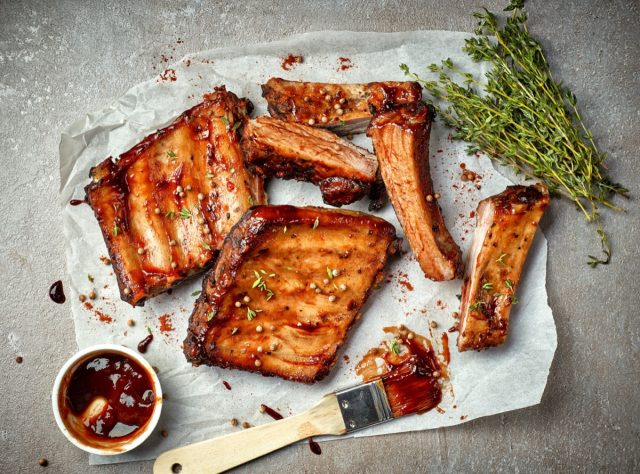
Sodium Count: An estimated 300 mg of sodium per 1/4 teaspoon
Routhenstein says, "Barbecue spice rubs can make some foods taste delicious, but if you look closely the first ingredient is usually salt, and some contain sodium glutamate and/or garlic salt as well, which can bump up the salt content to about 300 mg for just a measly portion of 1/4 teaspoon! Consider making your own spice blend or looking for a salt free version. Combining garlic powder, cayenne powder, chili powder, cumin and black pepper packs in the flavor with an antioxidant boost and without the excess sodium."
Taco Shells or Tortillas
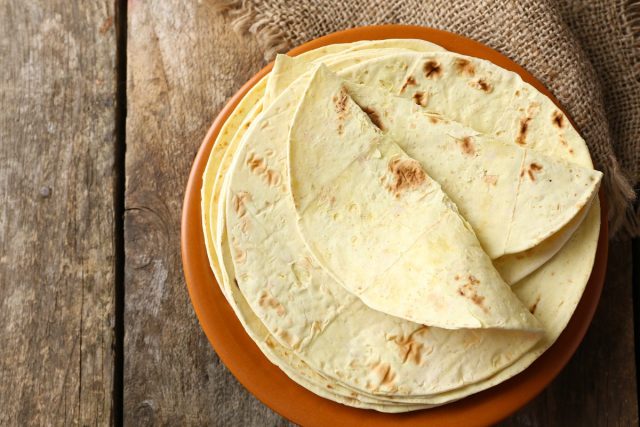
Sodium Count: 320 mg sodium per tortilla, for example
A taco shell is a type of food that is typically made from a thin, flat, and crispy round or triangular shape of corn or wheat tortilla. It is typically used as a container or wrapper for various types of fillings, such as ground beef, chicken, fish, beans, vegetables, and cheese. Some can be as salty as your fillings. According to Routhenstein, "One taco tortilla shell can pack 320 mg of sodium! Read your labels carefully and make sure to total it into your whole meal to fully assess the salt content and help to lower your blood pressure." Same can go for tortillas. The Mission Carb Balance Tortilla, for example, has 320 mg of sodium per single serving.
Rotisserie Chicken
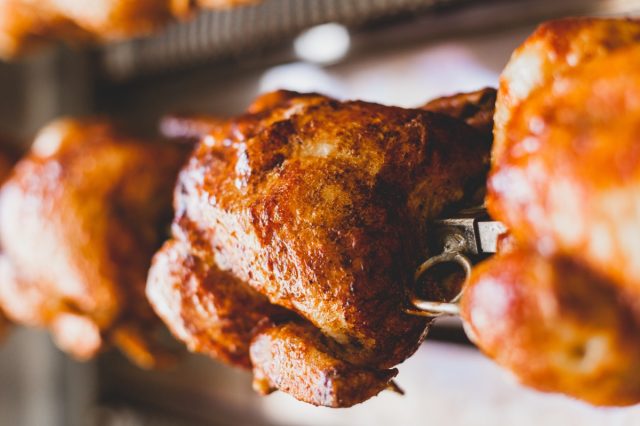
Sodium Count: 330 mg of sodium and up, per piece
Rotisserie chicken is a type of roast chicken that is cooked on a spit or rotisserie. The spit is a long, vertical rod that is placed in the center of an oven, and the chicken is skewered on the rod and cooked slowly as the rod rotates. This cooking method allows the chicken to cook evenly and to develop a crispy, golden-brown skin.
Dr. Mitchell says, "Rotisserie chicken seems like a convenient and affordable way to get in your protein without too much fuss; however, just because it is convenient and affordable doesn't mean it isn't harmful to one's health. Salt can be an important part of a healthy diet when consumed in moderation. Unfortunately, the actual sodium content found in rotisserie chickens can be chaotic and difficult to estimate due to a lack of labeling on the product itself or on the packaging."
Certain Cheeses Like Blue Cheese
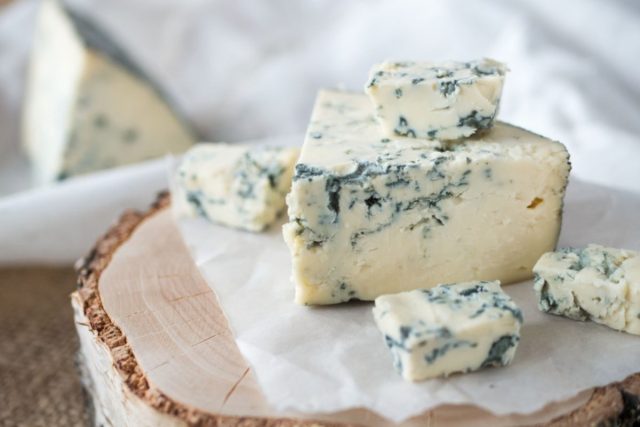
Sodium Count: 395 mg of sodium or more, depending on the cheese and serving size
Routhenstein explains, "The amount of sodium will differ based on which cheese you choose, but some very salty cheeses like blue cheese have 395 mg of sodium for 1 ounce! Be sure to not only check the amount of sodium on the label, but assess the amount you consume to accurately assess your sodium intake."
Egg Bite
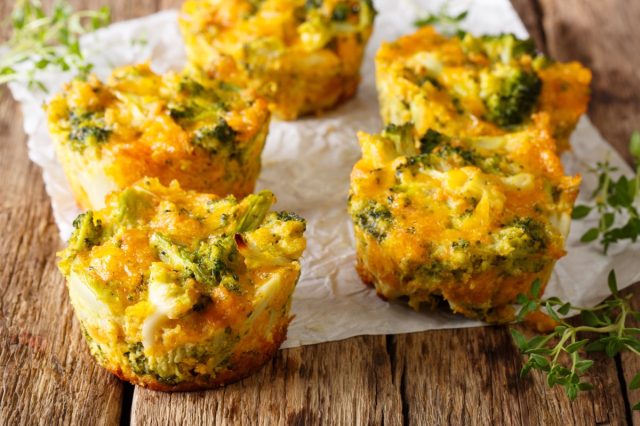
Sodium Content: An estimated 410 mg of sodium or more
Routhenstein says, "One fresh or frozen egg bite can contain about 410 mg of sodium per egg bite. Some of this is due to the added cheese, uncured bacon, and salt. These can be made ahead of time in your kitchen, and frozen for when it is convenient for you. When you make it at home, you have more control of the sodium intake and add in potassium rich vegetables like red bell peppers to improve blood pressure control as well." These little guys really do pack a punch. The cheese, spinach & Kale version of Trader Joe's Egg Bites have a whopping 520 mg of sodium.
Instant Pudding Mix Packs
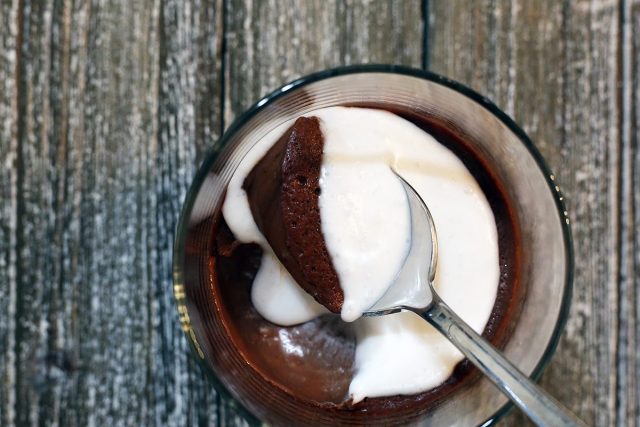
Sodium Count: 430 mg of sodium or more per ½ cup
Routhenstein shares, "1/2 cup of instant pudding mix packs in 430 mg of sodium, which may surprise you because it is masked with the sweetness! Some ways to cut back on sodium from instant pudding is to use the dry pudding mix with no added salt and add your own natural flavors to it. If you enjoy the convenience of instant pudding, you can either dilute it with water to lower the sodium content and pair it with high potassium fruit like cantaloupe to balance it out." The Chocolate Jell-O pudding mix indeed has 430 mg of sodium.
Baked Beans
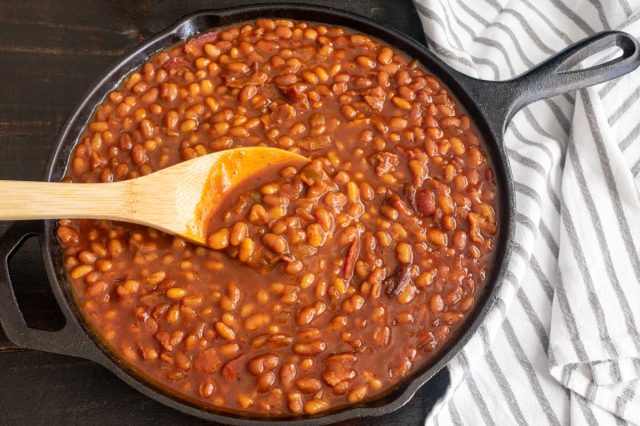
Sodium Count: 520 mg of sodium per half cup
Routhenstein states, "Baked beans have 520 mg of sodium for 1/2 cup! While beans are beneficial for blood pressure lowering due to its potassium, magnesium, and soluble fiber content, we want to be mindful of the added salt found in baked beans and some regular canned beans as well. Choose no salt added varietes when possible, and choose tetra bagged or boxed beans like the ones from Green Valley Organics."
Dr. Mitchell shares, "Baked beans are found in a variety of traditional comfort foods, like chilies and burritos, but their health impacts must not be forgotten. Baked beans are often high in sugar and sodium content and can be a significant source of calories. Eating too much can lead to significant weight gain, and consuming them on a regular basis can increase your risk of chronic diseases like diabetes. Therefore it's important to be aware of the quantities consumed each time you indulge in this tasty treat. Used sparingly as part of a balanced and varied diet, baked beans can make an enjoyable addition to many dishes."
Low Sodium Soy Sauce
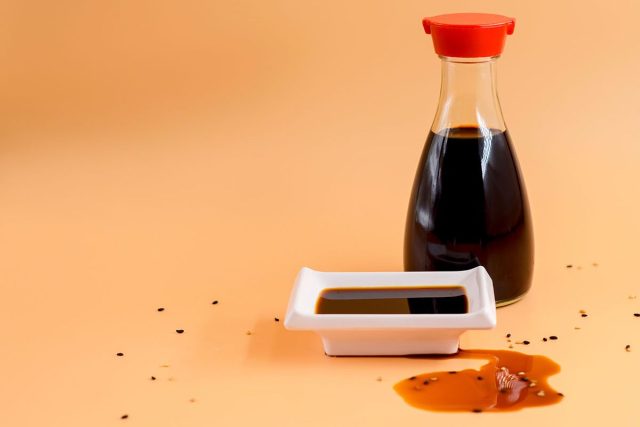
Sodium Count: 570 mg of sodium for 1 tablespoon
Routhenstein says, "Low sodium soy sauce has 570 mg for 1 tablespoon of sodium which is not a low sodium food. A good substitute would be coconut aminos which has 270 mg for 1 tablespoon, which decreases sodium by 300mg per serving and still imparts the desired umami flavor."
Dr. Mitchell says, "Many of us struggle with diets that are low in sodium. A delicious and easy way to add flavor to our dishes is soy sauce; unfortunately, that also adds an excessive amount of salt. To combat this, those striving for lower sodium can switch out their soy sauce for coconut amino. At 272mg per tablespoon, the reduction in sodium is a whopping 300mg! Not only does it decrease salt intake but it also has the same umami flavor profile so you won't be missing out on anything. Coconut amino is a great substitute for those trying to reduce their sodium intake without sacrificing flavors."
Tomato Juice
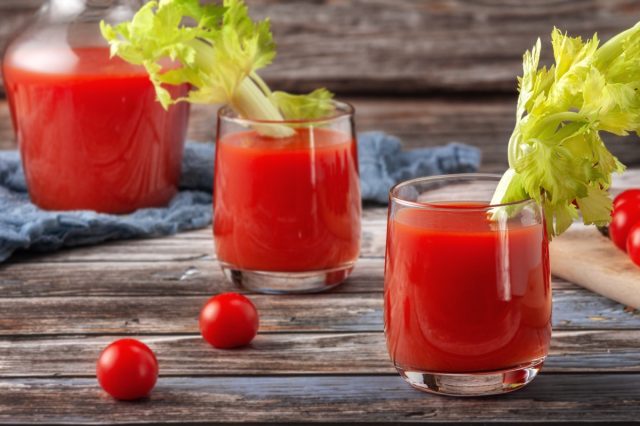
Sodium Count: 640 mg of sodium per 8 oz serving
Routhenstein reveals, "While tomatoes can help lower blood pressure because of lycopene, potassium, and folate, the added sodium to tomato juice can constrict the arteries and cause a rise in blood pressure. Even low sodium varieties can defer you from your blood pressure goals because of a concentrated sugar content that can impede on insulin resistance which can play a negative role in increasing blood pressure. If you like the taste, consider choosing 100% varieties with no added sugar and adding a splash in water instead."
Frozen or Packaged Meals
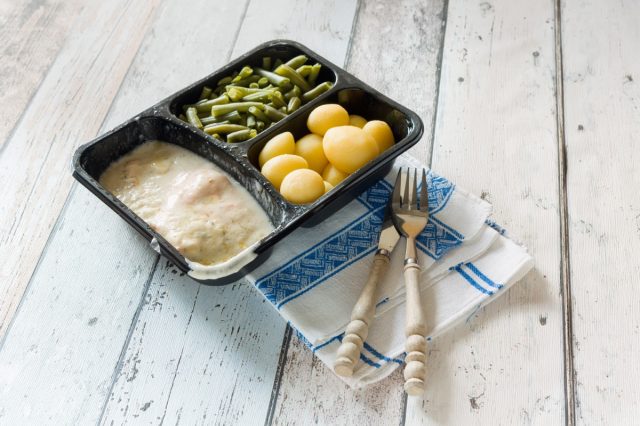
Sodium Count: 700 mg of sodium or more
Frozen meals are quick and easy, but not the healthiest choice. One reason is that many TV dinners are high in sodium, which can contribute to high blood pressure and other health problems. They also often contain a high amount of added sugars, which can contribute to weight gain and other health problems such as diabetes and heart disease.
TV dinners are also often low in fiber, which is important for maintaining a healthy digestive system and preventing constipation. They may also be low in nutrients such as vitamins and minerals, as they are often made with processed and highly refined ingredients.
Champion states, "Many convenience meals contain very high amounts of sodium, which can contribute to high blood pressure. Not only that, but they are often low in vitamins and minerals and high in saturated fat, which can lead to heart disease. Frozen meals are very convenient in today's busy world, but keep in mind that they are not all created equal. Look for meals that are lower in sodium and pair with a side salad or other veggie to boost up the fiber and nutrition."
Canned Soup
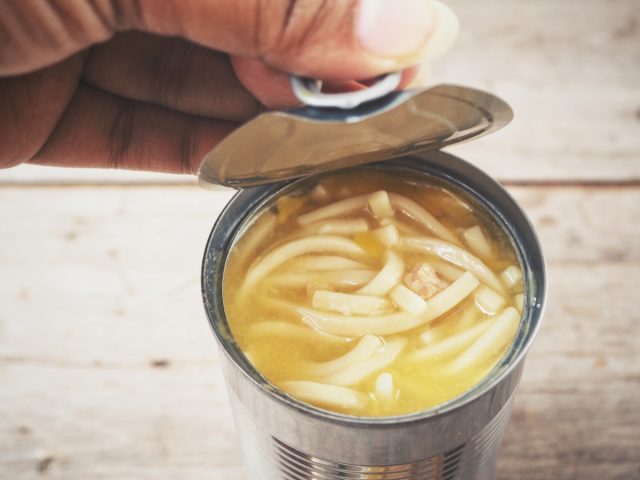
Sodium Count: 890 mg of sodium or more
A ½ cup of Campbell's chicken Noodle Soup has 890 mg of sodium. Sara Riehm, RD, LD/N, CSOWM Orlando Health Registered Dietitian Certified Specialist in Obesity & Weight Management tells us, "Because salt is used as a preservative and to flavor canned goods, the majority of canned soups tend to be very high in sodium. I prefer to make my own soups. This allows me to monitor how much sodium I'm including with my meal and customize the ingredients to my liking. Even so, sometimes a recipe will call for a canned soup. In that case, I'll look for the low-sodium version of whichever product I need and take time to review the nutrition facts labels to choose the brand with the least sodium."
Processed Meats
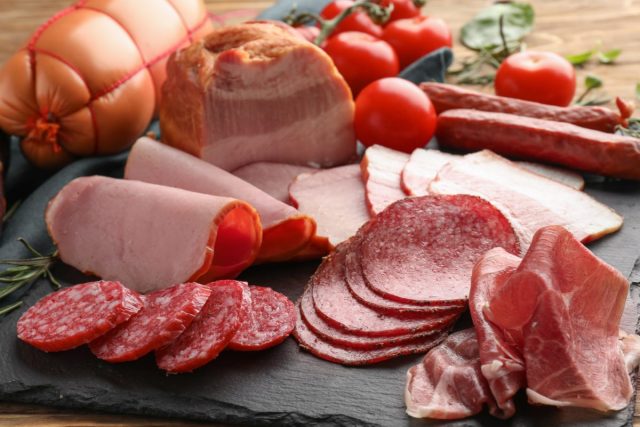
Sodium Count: Up to 1,000 mg of sodium and beyond
Champion says, "Processed meats contain very high amounts of sodium and low amounts of nutrients. They have also been linked to increased rates of cancers. These foods can contribute to increased blood pressure, and they really aren't providing many healthful nutrients. Instead of eating a processed deli meat chicken sandwich for lunch, choose whole, roasted, sliced chicken or turkey with mustard, lettuce, and tomato on whole wheat bread. You can purchase a whole breast, roast it, and slice. If that's too much for you to consume in a few days, freeze some for another time. This is a healthier option with much less sodium."
Riehm adds, "Sausages, salami, bacon, jerky, and ham are a few of the foods that fall into this category. A processed meat is one that has been preserved by smoking, canning, salting, or curing. I avoid these foods as often as I can and save them for special occasions only—if that. Not only are they high in sodium which can compromise our heart health, recent studies have shown that eating processed meats can increase our risk for certain cancers. Instead, I look for plant-based sources of protein. Examples include beans, peas, lentils, tofu, and more. These foods are high in vitamins, minerals, and fiber which are nutrients essential to maintaining our health."
Baking Soda
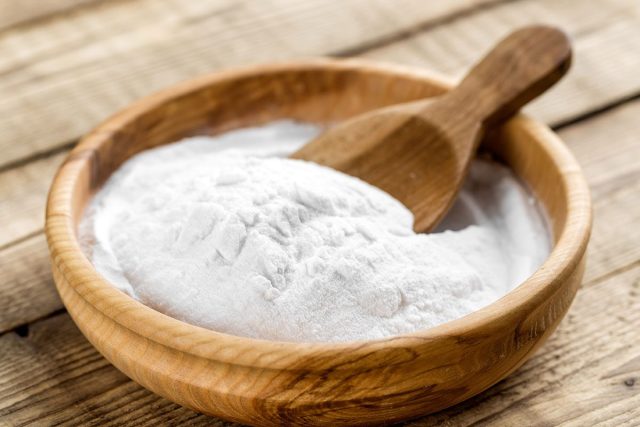
Sodium Count: 1,260 mg of sodium per teaspoon
Routhenstein says, "While you won't eat baking soda by the spoonful, it can be added to many breads or baked goods or on an ingredient list of a recipe you are using. Baking soda is 100% sodium bicarbonate and 1 teaspoon contains 1,260 mg of sodium! Be sure to take this into account, especially when you are baking with both baking soda and baking powder because it can surely add up."
Frozen Pizza

Sodium Count: 1,400 mg of sodium and beyond
Everyone loves a good frozen pizza, but it can skyrocket your blood pressure. Depending on the type of frozen pizza, you could be eating two day's worth of sodium with just one pizza.
Riehm says, "Have you ever flipped over your favorite frozen pizza to see the sodium content? My first time doing this left me with a bit of sticker shock. Some frozen meals can contain more than half of the daily recommended intake for sodium (2,300 mg per day for most people or 2,000mg per day if you have high blood pressure). If I can't make my own pizza at home, I check the nutrition label and look for the least salty option. Often this means forgoing any pizzas that have pepperoni, sausage, or ham as these meat toppings contain lots of sodium."